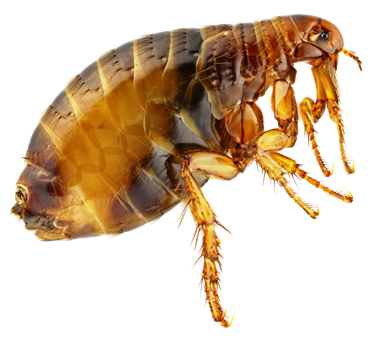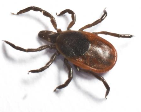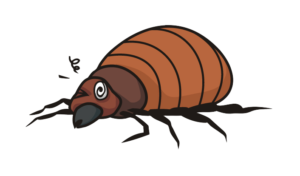
Flea and Tick treatment:
Fleas are small, wingless insects that feed on the blood of animals and people. Americans spend about $9 billion a year controlling fleas – one of the biggest expenses for pet owners.
In Texas, most flea problems are caused by the cat flea, Ctenocephalides felis. This flea feeds on cats, dogs and wildlife. Other kinds of fleas, such as the dog flea, human flea and rat flea are less common on pets and in homes. Fleas can be a source of both irritation and disease. Dogs and cats scratch constantly. Those who are allergic to flea bites can have very serious effects as a result of only 1 or 2 bites. Cat fleas do not normally live on humans but do bite people who handle infested animals. Flea bites can cause small, red, itchy bumps, usually on the ankles and lower legs. Fleas that have fed on rodents may transmit diseases including plague and typhus. For this reason, avoid contact with wild rodents such as squirrels, rats and prairie dogs. Their fleas can bite you and may transmit disease. Cat fleas, however, do not carry plague.

Ticks:
Ticks are a big pest concern in our area of the country. Many ticks like moist warmth – which is a perfect description of Houston. This is especially of concern if you have a pet. There are a variety of ticks that you or your pet can encounter in Texas when outdoors.
The American dog tick (Dermacentor veriabilis): This tick is widely distributed east of the Rocky Mountains. It transmits Tularemia and Rocky Mountain spotted fever. The highest risk of being bitten occurs during spring and summer. These are sometimes called wood ticks.
Blacklegged Tick (Ixodes scapularis): Also known as a Deer Tick. It is widely distributed across the eastern United States. It can transmit Lyme disease as well as other diseases. The greatest risk of being bitten exists in the spring, summer, and fall. However, adults may be out searching for a host any time winter temperatures are above freezing. Stages most likely to bite humans are nymphs and adult females.
Brown dog tick (Rhipicephalus sanguineous): This tick is found worldwide. It transmits Rocky Mountain spotted fever. Dogs are the primary host for this tick, but it may also bite humans or other mammals.
Gulf Coast tick, (Amblyomma maculatum): Found along coastal areas of the US along the Atlantic coast and the Gulf of Mexico. It transmits a form of spotted fever. Larvae and nymphs feed on birds and small rodents, while adult ticks feed on deer and other wildlife. Adult ticks have been associated with transmission of R. Parkeri to humans.
Lone Star tick, (Abblyomma americanum): Distributed in the southeastern and eastern US. Transmits human ehrlichiosis and other viruses and disease. This is a very aggressive tick that bites humans. The female is distinguished by a white dot on her back. The tick saliva can be irritating; redness and discomfort at a bite site does not necessarily indicate infection.
The general life cycle of a hard tick: Egg – larva (has six legs); nymph (has eight legs); adult (also has eight legs); All three stages (nymph, larva and adult) require at least one blood meal per stage to grow and develop. The different stages (larva, nymph and adult) are progressively larger in size. Nymphs are distinguishable from adults primarily by size.
Tick Prevention: There are ways to control / prevent ticks with habitat modification. Since ticks must be in areas of high humidity in order to survive, they are most commonly found in shaded grassy, brushy, or wooded areas. Keeping grass well-mown, removing brush regularly, and pruning trees to allow for more sunlight to penetrate to the soil surface will discourage ticks from becoming established in these areas. In addition, reducing vegetative cover will prevent a harborage for mice, the principal reservoir host of the spirochete for Lyme Disease. Use of a thin layer of mulch, one to two inches in depth, or bare soil around shrubbery also helps to reduce habitat.
Tick Removal: They should be removed from pets and humans as soon as they are noticed. When ticks latch on to you or your pet, they can’t easily be plucked off as their grip is exceptionally strong. Ticks should be removed carefully and slowly. If the attached tick is broken, the mouthparts left in the skin may transmit disease or cause secondary infection. Ticks should be grasped with tweezers at the point where their mouthparts enter the skin and pulled straight out with firm pressure. A small amount of flesh should be seen attached to the mouthparts after the tick is removed. To be safe, any flu-like symptoms that occur within two weeks following the bite of any tick should be reported to your doctor.
Fun Facts:
- Just one flea can become 1,000 on your pet and in your home in only 21 days.
- A flea can jump 30,000 times without stopping and reserves direction with every jump.
- 95% of flea eggs, larvae and pupae live in beds, rugs, carpets and sofas – not on your pet.
- Ticks are daredevils. They do not jump or fly but stand on the top of a blade of grass waiting for a host to walk by. When they do, they reach out their front legs and grab on. This is called ‘questing’. Sometimes, they jump from a higher perch to drop on the potential host. Sounds sort of like an Avenger – except that we hate ticks.
- Ticks are actually not insects. They are classified as arachnids – relatives of spiders and scorpions. Not surprising when you look at them up close.
How do we get rid of these bugs?
When you have a pet, flea and tick treatment requires a coordinated veterinary pet treatment and a professional pesticide treatment of the infested area of home and/or yard. Also – reapplications may be necessary to eliminate them. These are a difficult infestation to treat! It’s a reproductive issue with these bugs. Fleas are constantly laying eggs and shedding them. The young can remain dormant in the pupa stage for up to six months, then hatch in seconds in the right conditions. Ticks also go through a life cycle, but they tend to be outdoors though then they are brought in with pets or on clothing.
So, the treatment of these multiplying bugs, usually requires us to treat the outside and inside of the house and it is critical to make sure the pet is continuously treated. Also, if you do not have a pet but likely have a rodent problem (either inside or outside) then that issue must be solved as well. The focus of our chemicals is to cover the egg masses, thus preventing them from maturing and biting, and providing extermination of the young ticks before they become a problem.
All of this requires specialized chemicals. These need to be applied carefully and using the correct methods to provide a safe treatment. Our team of experienced technicians can provide full treatment, as well as flea and tick extermination, in your home and yard.
Give us a call today at 281-954-BUGS (2847)


